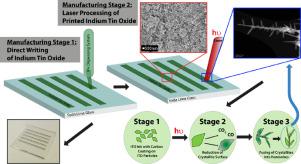Applied Materials Today ( IF 7.2 ) Pub Date : 2020-09-21 , DOI: 10.1016/j.apmt.2020.100835 J.R. McGhee , A. Goulas , D.J. Southee , J.S. Sagu , D.S. Engstrøm , J. Wang , D.A. Hutt , P.S.A. Evans , Z. Zhou , K.G.U. Wijayantha , P. Conway , C.J. Carmalt

|
Metallic and semiconductor nanowires can provide dramatically increased electrical and optical properties in a wide range of fields, ranging from photovoltaics to sensors and catalysts. In this research, a rapid manufacturing process has been developed for printing indium tin oxide microparticles and converting them into nanowires. Microparticle indium tin oxide (ITO) inks were formulated and printed. These were then converted into hierarchical nanowire films via laser irradiation (980 nm, NIR) with raster speeds of 40 mm s−1 in air, much faster compared to traditional manufacturing processes. For a 4 cm2 film, only 40 s of processing were required. A full materials characterization was performed on the materials pre and post laser processing with the most probable conversion mechanism found to be a laser induced carbothermal reduction process. Microstructural, chemical, and crystallographic evidence of the laser induced carbothermal reduction process were derived from SEM, XRD, XPS and TEM analysis. Compared to conventionally heat-treated printed samples, laser processing was found to increase the conductivity of the printed ITO from 0.88% to 40.47% bulk conductivity. This research demonstrates the ability of printing and laser processing to form nanowires in a high-speed manufacturing context, thereby enabling the development of printed non-transparent ITO nanowire electronics and devices.
中文翻译:

通过印刷和激光照射制造的氧化铟锡纳米线
金属和半导体纳米线可在从光电器件到传感器和催化剂的广泛领域中提供显着提高的电学和光学特性。在这项研究中,已经开发出一种快速制造工艺,用于印刷铟锡氧化物微粒并将其转换为纳米线。配制并印刷了微粒铟锡氧化物(ITO)油墨。然后将它们通过激光辐照(980 nm,NIR)在空气中以40 mm s -1的光栅速度转换为分层的纳米线薄膜,比传统制造工艺要快得多。对于4厘米2胶卷,只需要40 s的冲洗时间。在激光加工前后的材料上进行了完整的材料表征,发现最可能的转换机制是激光诱导的碳热还原过程。激光诱导碳热还原过程的微观结构,化学和晶体学证据来自SEM,XRD,XPS和TEM分析。与常规热处理的印刷样品相比,发现激光加工可将印刷ITO的电导率从0.88%提高到40.47%。这项研究证明了在高速制造环境中印刷和激光加工形成纳米线的能力,从而促进了印刷非透明ITO纳米线电子器件的开发。











































 京公网安备 11010802027423号
京公网安备 11010802027423号